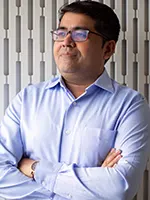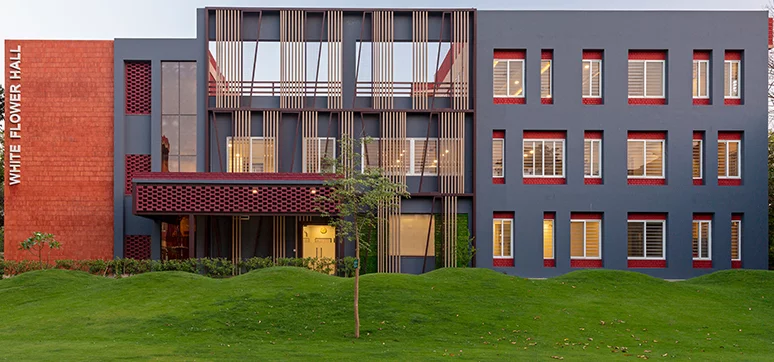We had the pleasure of interacting with Ar. Vishal Kakkar and Ar. Meena Murthy Kakkar. Both spoke about a range of subjects including their architectural practice – Envisage, their take on sustainability, recent projects, the latest trends in façade and fenestration designs and technologies, and the way building façade and cladding will take shape during the 21st century.

Could you tell us about your educational background and career?
Vishal: Both of us are architecture graduates from the School of Planning and Architecture, Delhi. We co-founded Envisage in 2007, an interior and architecture firm specializing in design and build projects that offer turnkey solutions from conceptual design to execution at the site. Meena is also an associate professor, and I am a guest lecturer at the School of Planning and Architecture, Delhi.
What inspired you to pursue a career in architecture?

Vishal: My father was a builder in North Delhi, and I would constantly accompany him to architectural sites since I was a kid. Venturing into architecture and design was the next step in my career trajectory.
Meena: I have always been a curious and empathetic child. Always dreaming and imagining different possibilities for approaching any situation, a career in design was a natural progression for me. After graduating from SPA, Delhi, we both understood the nitty-gritty of designing a space considering its mass, volume, and proportions. One of the branches that we meandered into was interior design, although the architecture is our primary focus.
Tell us about your design practice Envisage?
Meena: Commencing formal operations in 2007, Envisage specialises in the design and build of projects and offers turnkey solutions from conceptual design to execution. The studio has designed and executed over 100 projects from conceptualisation to completion in the residential, commercial and institutional sectors. All the designs successfully walk the tightrope of design thoughtfulness and cost-effectiveness, a combination that has become the studio’s USP.
Vishal: Our team’s broad experience spans various typologies and has helped expand creative boundaries – the firm focuses on residential and institutional design in addition to corporate and hospitality design. Based out of Gurugram, we are known for varied, comprehensive, and, most importantly, client-focused architecture and interior design solutions.

What were the turning points in your design career?
Vishal: Looking back at Envisage’s journey of over 15 years, I would say a huge turning point was when we received our first large-scale project, a school in Azamgarh, Uttar Pradesh. It gave us the scope to create an impact and understand the process of larger built projects.
Meena: As a studio, Envisage evolved a step further when we adopted social media as a tool for engagement. It broadened our horizons, connected us with like-minded people, vendors and peers, and gave us a different perspective on design and the built form. We’re just 3-4 years old with our presence on social media, but it has undoubtedly helped us change for the better.

What type of projects does envisage specialize in? What type of services do you offer to your clients?
Vishal: Envisage specialises in architecture and interior projects in the residential, commercial and institutional sectors. We provide turnkey solutions from conceptual design to execution. Moreover, we aim to create spaces that authentically represent their inhabitants while being sustainable in all aspects. Our team stands strong for the firm’s core value— ‘social consciousness in harmony with economic and environmental sustainability’ by working towards creating spaces with a responsive design narrative.

Meena: We also delve deep into creating an acute representation of Indian tradition-inspired concepts. Being vocal for locals, we encourage art and craft created by local artisans and incorporate them into all their projects abundantly. Actively working towards reviving our lost heritage, Envisage consciously curates spaces that bridge the gap between the past and present through local art, materials, patterns, and design elements that hold nostalgic sentiments.
What is your take on sustainable practice in architecture today?
Meena: Architecture exists at many levels – from large-scale mixed-use projects to the smallest of houses. Today, people have started discussing sustainability across the entire spectrum of the built environment, which was not the case previously. The significant difference is that previously, this conversation revolved around economic reasons, but now it has become a prerequisite for many. That being said, India as a community and culture has been highly sustainable from the past itself with systems like vernacular architecture. The importance of those methods and practices is being realised and spoken about today, which is highly required. Post the pandemic; everyone is in a good learning mode. Learning from our old practices or even from the global market, like new technology, has enabled us to be open to ideas to make a significant difference.
How would you define your design process for façades and fenestrations in your projects?

Vishal: At Envisage, we work on residential, commercial and institutional projects. If we have the scope to design residential and institutional projects from ground zero, we consider their orientation and direction in the design process.

Talking about the process, the micro-climate and the alignment of the structure take the highest priority, followed by the views around and then the façade of the building. This is so because the penetrations need to face the right direction and have the correct size of the openings, to get lots of light and air into the space so that your dependence on artificial light is restricted to a minimum. The aesthetics of the elevation takes a slightly lower priority because the end user will experience the building from the inside, while the elevation is what one sees from the outside.
Meena: For projects for which alterations to the elevation cannot be made, we always suggest our clients change the type of openings. Changing the windows from wooden to uPVC or aluminium windows with bug meshes, enables the penetration of abundant natural light and air into the space.
Please talk about some most preferred façade materials.
Vishal: There’s been an enormous revolution in the building material market. Aluminium is the forerunner in façade materials, as they are incredibly lightweight and available in sheets, different colours and styles. It has the potential to create fancy surfaces by combining its various forms and textures. Aluminium is also very long-lasting.
Laminam is also a great option to work with nowadays, which can be wet or dry cladded, although we prefer it to be dry cladded so that it doesn’t fall off. If the budget allows, cladding materials like brick tiles and stone can be used. That being said, aluminium is competitive in price and is a forerunner to façade materials. It is also sustainable compared to other materials because of its recyclability and long-lasting characteristics.
Could you please brief me on the latest trends in façade and fenestration designs and technologies?

Meena: The latest façade trends that intrigue us are kinetic façades. For example, considering Delhi’s harsh winters, kinetic façades that could move around to accommodate the changing sunlight would be a great solution. We hope these façades become accessible in India at an economical price soon. Apart from that, façades with solar panels are exciting too! The issue currently is that these façade options are not cost-effective. At the end of the day, façade treatment needs to be economical as the heavy civil work of buildings is quite expensive.
Please throw some light on a few of your favourite projects.

Vishal: Girls Hostel at Mann School, Delhi: The Girls Hostel for Mann School’s design centres on the importance of holistic facilities that encourage learning at home-away-from-home. The front elevation breaks away from the heavy brick-finished façade, which respectfully incorporates reds and greys to develop a sentimental yet practical environment for the students. To improve the well-being of the children, outdoor spaces, as well as greenery, have been prioritised.
Meena: Saraswati Global School, Faridabad: The vision for the Saraswati Global School centres on creating a vibrant building that encourages learning outside the classroom as much as inside. The building is also oriented to open out towards the field in the north, enabling optimum natural light, while the south wall has been fitted with vertical sunshades and double-glazed windows to cut off direct glare.
What is your vision for future façades, say about 50 years from now?
Meena: As said, we believe that kinetic and moving façades are the future. Kinetic windows that turn into balconies are in the making. It just needs to reach us faster!

What’s your advice to young and upcoming architects?
Vishal: Upcoming architects need to understand the site, climate, and soil exceptionally well to do justice to the building in terms of façade and fenestration. Putting effort into thinking of appropriate materials to use is of utmost importance.
Looking at traditional architecture systems worldwide and not just in India, the façades form an integral part of making the internal space comfortable according to the climate it is set in. Be it the jharokhas of Rajasthan’s built form or the slits of the bastakiya, to the rose windows of cathedrals in cold areas— all are designed to let a certain amount of light and ventilation into the space. So, if you want to do a good job creating a façade and its fenestrations, you must understand its site context well.















